Navigation
Install the app
How to install the app on iOS
Follow along with the video below to see how to install our site as a web app on your home screen.
Note: This feature may not be available in some browsers.
More options
Style variation
-
Congratulations cowski on being selected by the Eng-Tips community for having the most helpful posts in the forums last week. Way to Go!
You are using an out of date browser. It may not display this or other websites correctly.
You should upgrade or use an alternative browser.
You should upgrade or use an alternative browser.
Baltimore Bridge collapse after ship collision 125
- Thread starter Tomfh
- Start date
- Status
- Not open for further replies.
TugboatEng
Marine/Ocean
I am commenting that there is zero information. In the case of an airplane crash there would have been a statement of facts by now. For maritime incidents we get nothing. Maybe I want people to notice this. Maybe I don't...
-
1
- #362
Brian Malone
Industrial
I don't see an urgency for information to be released on a regular basis. Until the channel is cleared and a new bridge is funded for construction, the absolute details of this mishap are more a curiosity, no? Would knowing more details help anyone commenting on the thread do their job safer, do their job better, protect their loved ones, make more money? Many of us commenting are thousands of miles from the location and it doesn't affect us immediately. Sure, some are nearby and that may cause some consternation. But knowing more details won't clear the channel or raise a bridge any faster. Even with airplane crashes and industrial accidents, the investigation by NTSB, OSHA, CSB, NIST, etc. is commonly drawn out over years. Certainly, there is going to be controlled release of info until the litigation is settled. Is there a reason to consider any nefarious actions are in play?
In a sense you are right but in our interconnected world, the implications are broad. The immediate impact is Baltimore and all of those citizens have a need to know. More generally, if my new Beemer comes through any port plugged up by backlog, so do I, even if I'm 4666 km from the incident.
At a more fundamental level, we all have a right to know that our social structures are functioning well. It is a basic sense of security that is more than an expectation. This, if nothing else, drives the efficiency of our society so yes, it does speed things up.
At a more fundamental level, we all have a right to know that our social structures are functioning well. It is a basic sense of security that is more than an expectation. This, if nothing else, drives the efficiency of our society so yes, it does speed things up.
-
1
- #364
I don't know what agency is responsible to investigate, whether NTSB, NHTSA, the Coast Guard, or whomever. Tug is right that somebody should be expected to periodically release information. In today's world, we'll hear a story about a flat tire on an F-18 with a reminder that since Boeing built it, we could somehow try to tie it to the 737 MAX. You would think the news outlets would want anything to report on it.
Brad Waybright
The more you know, the more you know you don't know.
Brad Waybright
The more you know, the more you know you don't know.
LittleInch
Petroleum
Just do a quick google.
The NTSB were first on the scene and they are looking at the incident to determine what happened. They have got hold of the electronic data from the vessel (Voyage data recorder) plus the bridge voice recorder. Apprently the data recorder stopped on loss of power, but the voice recorder kept going. They also have the last 30 days of data.
The USGC are looking to see if there were any violations of marine regulations,
Now thought the FBI have got involved so everyone else now has to back off as there were reports they left the port knowing that the electrical system wasn't good.
see e.g.
and from one website its the end of may for the inital report.
“We are just beginning our investigation into the incident,” said Homendy. “Our investigators are on the scene and are working closely with Hyundai, the manufacturer of equipment in the engine room, to download data from the electrical power system and examine the circuit breakers. That is where our focus is right now in this investigation.”
As disclosed, NTSB and its investigators are also looking at the original bridge design of the vessel and how it would be built today in line with the current standards.
“Of course that is preliminary and the investigation could take different paths as we continue our activities,” she added.
NTSB has retrieved the voyage data recorder from the vessel (VDR), which, according to Homendy, provides very brief information on what was going on in the engine room at the time of the incident.
The preliminary report from NTSB on the accident is expected by the end of May.
And apparently the owners have filed to limit their liability to the vessel value due to that 1850 law AND declared "general average" so anyone with good son board needs to pay up full value to get their own goods back.... don't you just love Maritime Law and insurance claims....
Remember - More details = better answers
Also: If you get a response it's polite to respond to it.
The NTSB were first on the scene and they are looking at the incident to determine what happened. They have got hold of the electronic data from the vessel (Voyage data recorder) plus the bridge voice recorder. Apprently the data recorder stopped on loss of power, but the voice recorder kept going. They also have the last 30 days of data.
The USGC are looking to see if there were any violations of marine regulations,
Now thought the FBI have got involved so everyone else now has to back off as there were reports they left the port knowing that the electrical system wasn't good.
see e.g.
and from one website its the end of may for the inital report.
“We are just beginning our investigation into the incident,” said Homendy. “Our investigators are on the scene and are working closely with Hyundai, the manufacturer of equipment in the engine room, to download data from the electrical power system and examine the circuit breakers. That is where our focus is right now in this investigation.”
As disclosed, NTSB and its investigators are also looking at the original bridge design of the vessel and how it would be built today in line with the current standards.
“Of course that is preliminary and the investigation could take different paths as we continue our activities,” she added.
NTSB has retrieved the voyage data recorder from the vessel (VDR), which, according to Homendy, provides very brief information on what was going on in the engine room at the time of the incident.
The preliminary report from NTSB on the accident is expected by the end of May.
And apparently the owners have filed to limit their liability to the vessel value due to that 1850 law AND declared "general average" so anyone with good son board needs to pay up full value to get their own goods back.... don't you just love Maritime Law and insurance claims....
Remember - More details = better answers
Also: If you get a response it's polite to respond to it.
Oh!! What have we here? A report from NTSB
JohnRBaker
Mechanical
Good timing, eh Tug?
John R. Baker, P.E. (ret)
Irvine, CA
Siemens PLM:
The secret of life is not finding someone to live with
It's finding someone you can't live without
John R. Baker, P.E. (ret)
Irvine, CA
Siemens PLM:
The secret of life is not finding someone to live with
It's finding someone you can't live without
First look says:
First blackout on the night lost the feed to the LV Bus - HV remained live, but the engine tripped because its cooling water pump is fed from LV. Nothing yet on what made the HV/LV link trip.
Once stopped, the engine stayed stopped - insufficient time and supporting machinery available to restart it.
Steering gear was available almost throughout but, with no propwash over the rudder, had insufficient authority to keep the ship on heading. Nothing yet on what pulled the ship off course - assume the final report will discuss wind, bank suction and cross currents from the Curtis Bay Channel as possibilities.
Second blackout on the night was both the running DGs tripping off the HV bus. Emergency LV bus remained live (thanks to the EDG) but everything else dropped off until they started a spare DG. Interesting, but no material impact on the outcome. Nothing yet on why this happened. Might shed some light on the causes of the first blackout - time will tell.
Two TLFs in port in days before. First sounds like a classic SNAFU. Second not well explained yet, but sounds like the prime mover on the standby DG wasn't fully serviceable when started in a hurry. Both sound like problems on the noisy end of the shaft coupling. Both the trips on the night sound like they were on the electrical side. No smoking gun at this stage to show that the accident was caused by the same thing as the incidents in port.
The crewmember who was on the foredeck dropping the anchor is going to have a hell of a war story to tell.
A.
First blackout on the night lost the feed to the LV Bus - HV remained live, but the engine tripped because its cooling water pump is fed from LV. Nothing yet on what made the HV/LV link trip.
Once stopped, the engine stayed stopped - insufficient time and supporting machinery available to restart it.
Steering gear was available almost throughout but, with no propwash over the rudder, had insufficient authority to keep the ship on heading. Nothing yet on what pulled the ship off course - assume the final report will discuss wind, bank suction and cross currents from the Curtis Bay Channel as possibilities.
Second blackout on the night was both the running DGs tripping off the HV bus. Emergency LV bus remained live (thanks to the EDG) but everything else dropped off until they started a spare DG. Interesting, but no material impact on the outcome. Nothing yet on why this happened. Might shed some light on the causes of the first blackout - time will tell.
Two TLFs in port in days before. First sounds like a classic SNAFU. Second not well explained yet, but sounds like the prime mover on the standby DG wasn't fully serviceable when started in a hurry. Both sound like problems on the noisy end of the shaft coupling. Both the trips on the night sound like they were on the electrical side. No smoking gun at this stage to show that the accident was caused by the same thing as the incidents in port.
The crewmember who was on the foredeck dropping the anchor is going to have a hell of a war story to tell.
A.
Just as a point.. When they say charges and detonate it will be cutting charges. /quote]
They were actual explosive charges, as shown in Jeff Ostroff's latest video
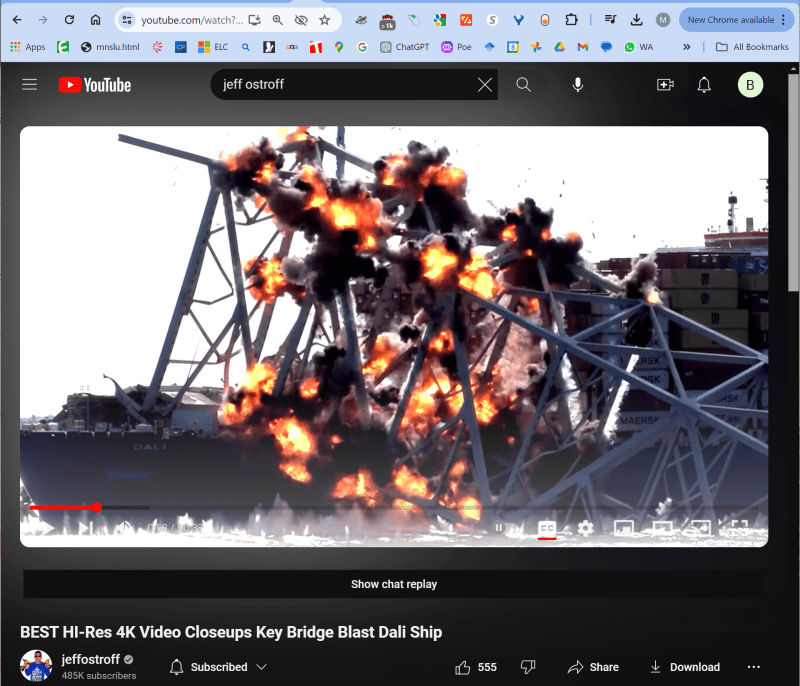
TTFN (ta ta for now)
I can do absolutely anything. I'm an expert! faq731-376 forum1529 Entire Forum list
TugboatEng
Marine/Ocean
Some thoughts. The initial trip occurred on both the high and low voltage side of the LV bus transformer. This would cause me to believe the fault was on the LV bus as breakers don't trip due to upstream faults (maybe the do?).
The next time around, the trips occurred on the high voltage generator bus tie breakers.
If the fault was on the LV bus and tripped HV breakers this indicates a circuit breaker coordination problem. That may explain the hesitancy to release the information as these switchboard built by Hyundai would have lots of copies floating around in the wild. If a faulty design is found who wants to make the decision to stop sailings for ships with affected units? That would be cause quite the supply chain disruption.
We did see quite a bit of black smoke. Does this indicate a generator overload? As I've said before there is no normal load condition that can make an electronic controlled engine smoke like that. Maybe a loss of RPM could create a condition that causes smoke.
The next time around, the trips occurred on the high voltage generator bus tie breakers.
If the fault was on the LV bus and tripped HV breakers this indicates a circuit breaker coordination problem. That may explain the hesitancy to release the information as these switchboard built by Hyundai would have lots of copies floating around in the wild. If a faulty design is found who wants to make the decision to stop sailings for ships with affected units? That would be cause quite the supply chain disruption.
We did see quite a bit of black smoke. Does this indicate a generator overload? As I've said before there is no normal load condition that can make an electronic controlled engine smoke like that. Maybe a loss of RPM could create a condition that causes smoke.
Alistair_Heaton said:The set up is a V with copper wire which gets turned into plasma that actually does the cutting. Its not a colossal bang (well it wasn't when i did it).
Wouldn't the noise from each cutting charge be directly related to the thickness and width of the metal cut? May explain a noisier event than expected.
Kevin Kelleher, P.E. (retired)
Internal Mechanical Eng'g Consultant
DuPont ESD Specialists
-
1
- #373
davidbeach
Electrical
Transformer fault would explain tripping both sides.
When one this sentence into the German to translate wanted, would one the fact exploit, that the word order and the punctuation already with the German conventions agree.
-- Douglas Hofstadter, Jan 1982
When one this sentence into the German to translate wanted, would one the fact exploit, that the word order and the punctuation already with the German conventions agree.
-- Douglas Hofstadter, Jan 1982
TugboatEng
Marine/Ocean
Boom may be a better word. There would be less boom with shaped charges because they don't take a lot of propellant. They do, however, benefit from a very fast burning propellant as their cutting action is velocity based. This would make more of a bang.
TugboatEng
Marine/Ocean
I am saying, knowing that nothing I work on has any coordination plan whatsoever but, it does seem like a transformer fault shouldn't be able to cause BOTH generators circuit breakers to trip. At least not without some fire and explosion. That's a lot of energy.
Eufalconimorph
Computer
TugboatEng said:This would cause me to believe the fault was on the LV bus as breakers don't trip due to upstream faults (maybe the do?).
Ohm's Law (for real power): E=IR. E is electromotive potential (voltage), I is current, Z is impedance (resistance + reactance). Frequencies are low enough we can pretend it's DC and use resistance in place of impedance.
Breakers trip when current exceeds some value for at least a minimum period of time.
There are two ways to increase current: increase voltage, or decrease resistance. If the downstream side has a short, that would decrease resistance, thus increasing current and cause a trip. If the generator output voltage increases somehow, that would increase current and cause a trip.
I'm not familiar enough with diesel generators (particularly not these ones) to say how likely a voltage surge from their output is, but I'd not want to say it's impossible, particularly since the HV breakers tripped. I'd assume they're variable-field generators, so a control fault increasing the field or allowing the generator speed to increase could cause such a voltage spike on the upstream side. A downstream fault seems more probable, but then the emergency generator kept the LV side up after it was started so it's hard to say.
Edit: Also in systems of this scale breakers can usually also trip on over or under voltage, or via SCADA control. The HV and LV breakers on the transformers may have been "ganged" so that if one trips the other will also trip to isolate the transformer. Etc. My point is just that even a simple fuse can blow due to either upstream or downstream failures.
On another note - Bridge blueprint
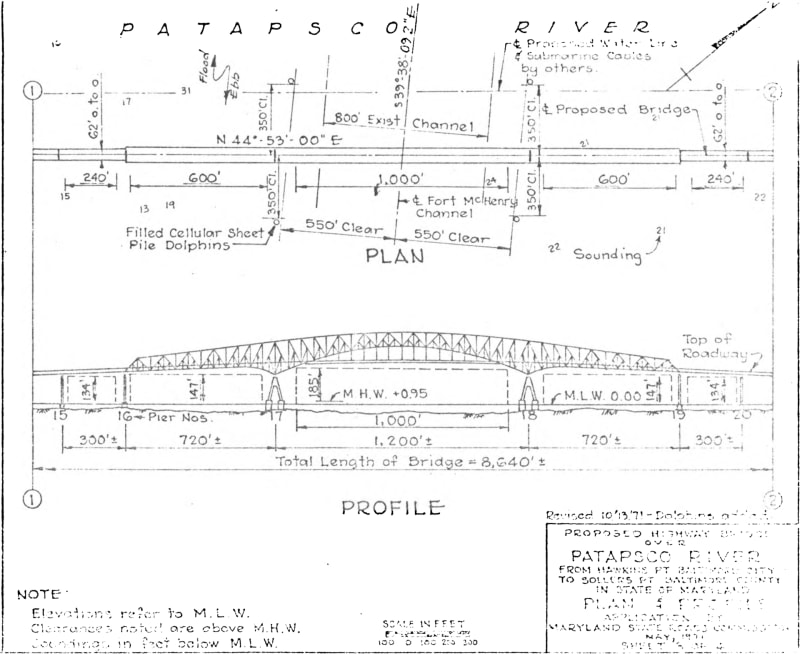
The pier header, a solid mass of concrete approx. 80' x 23' x 13.5' (roughly scaled from photos, Google Earth, etc.), rests on the deck of the Dali under the roadbed. Only one end is visible in the debris.
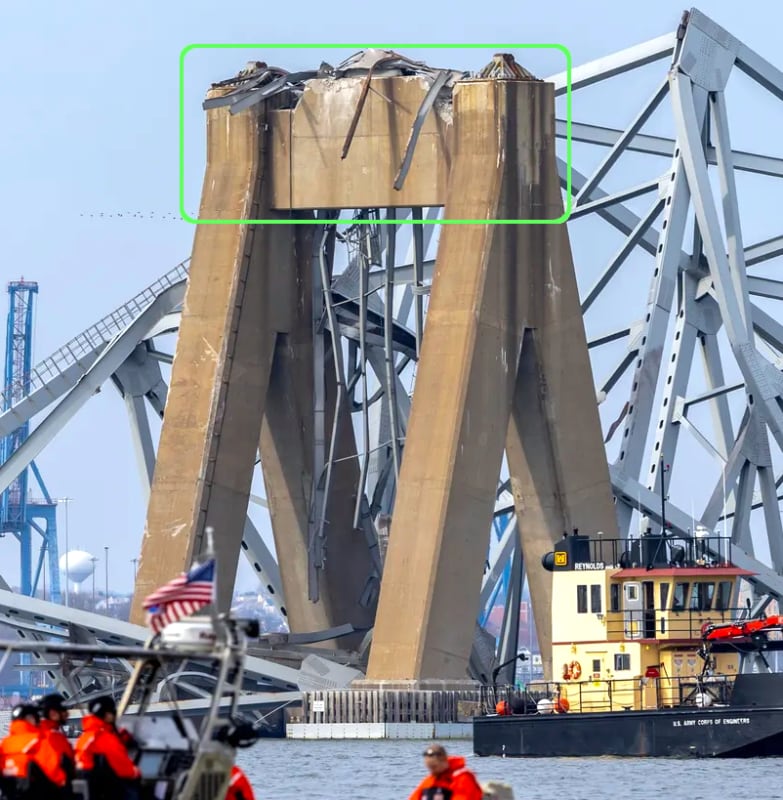
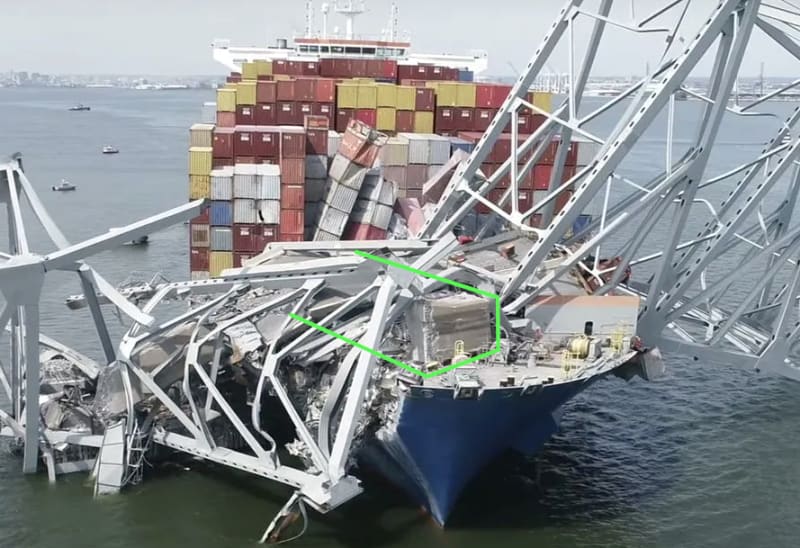
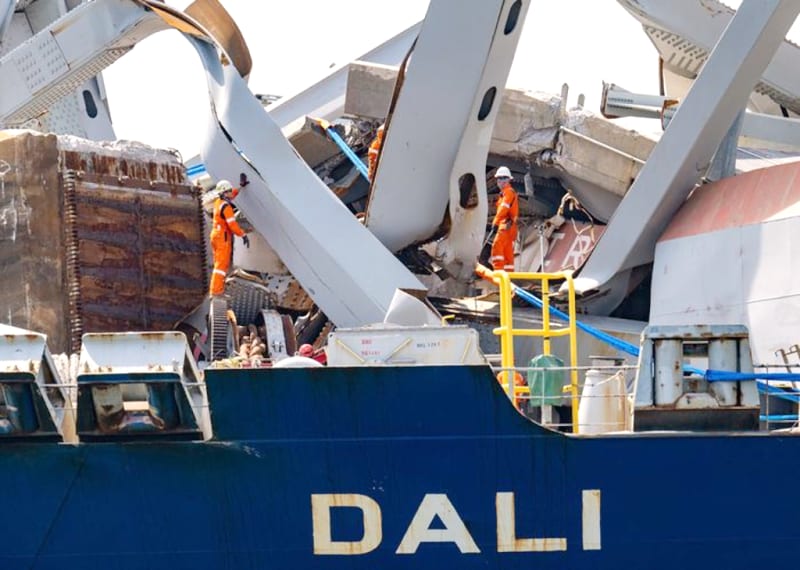
bearing seat at left (maybe 9' x 9')

The pier header, a solid mass of concrete approx. 80' x 23' x 13.5' (roughly scaled from photos, Google Earth, etc.), rests on the deck of the Dali under the roadbed. Only one end is visible in the debris.



bearing seat at left (maybe 9' x 9')
Good imaging...
-----*****-----
So strange to see the singularity approaching while the entire planet is rapidly turning into a hellscape. -John Coates
-Dik
-----*****-----
So strange to see the singularity approaching while the entire planet is rapidly turning into a hellscape. -John Coates
-Dik
Between that concrete mass, and the residual truss structure still resting both against and on the bow, the task of safely clearing the ship could take longer than assumed.
It appears the main reason for drive loss was a fault related to the cooling water pump for the mega-diesel engine. Could an existing emergency diesel generator (EDG) have been arranged to avoid this?
Kevin Kelleher, P.E. (retired)
Internal Mechanical Eng'g Consultant
DuPont ESD Specialists
It appears the main reason for drive loss was a fault related to the cooling water pump for the mega-diesel engine. Could an existing emergency diesel generator (EDG) have been arranged to avoid this?
Kevin Kelleher, P.E. (retired)
Internal Mechanical Eng'g Consultant
DuPont ESD Specialists
That's a great imaging compilation. I'm not sure if the torch cutting image is near the Dali?
When I see those stratigic demolation videos, I bet they first did "explicit" FEA predictions* of how the truss would fall apart, rolling off the side. They knew exactly how to alter the cutting strip plan to avoid the nearby hazardous containers.
*same method used to simulate NHTSA required new car crash testing capability, during the structural design phase.
Kevin Kelleher, P.E. (retired)
Internal Mechanical Eng'g Consultant
DuPont ESD Specialists
When I see those stratigic demolation videos, I bet they first did "explicit" FEA predictions* of how the truss would fall apart, rolling off the side. They knew exactly how to alter the cutting strip plan to avoid the nearby hazardous containers.
*same method used to simulate NHTSA required new car crash testing capability, during the structural design phase.
Kevin Kelleher, P.E. (retired)
Internal Mechanical Eng'g Consultant
DuPont ESD Specialists
- Status
- Not open for further replies.
Similar threads
- Replies
- 13
- Views
- 13K
- Question
- Replies
- 39
- Views
- 21K
- Replies
- 17
- Views
- 11K
- Replies
- 25
- Views
- 24K
- Replies
- 33
- Views
- 3K
